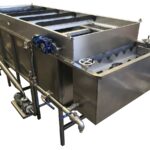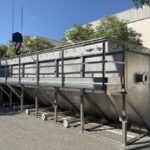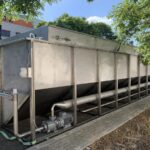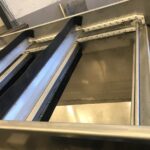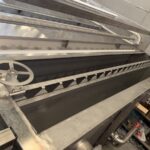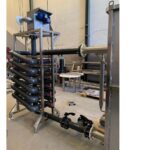Dissolved air flotation or DAF is the most widely used process to treat industrial and urban water, and one of its main uses is the reuse of water from desalination processes.
Dissolved air flotation can be appliedat different points of the water treatment line. This system allows the treatment of wastewater with a high load of suspended solids, water which needs a large flotation surface for optimum flotation and separation of solids.
The dissolved air flotation unit can be placed after the pre-treatment process in order to reduce oils and grease, and it is also very common to find them at the biological treatment inlet to reduce the pollutant load of the influent. It can also be used as a final clarifier before sending the discharge to the natural environment.
In desalination, this technology works as a membrane protector, preventing the presence of algae in the water. Finally, dissolved air floaters can be installed at the beginning of the sludge line with the function of thickening the sludge to reduce its volume.
Dissolved air flotation is based on a physicochemical process that separates solid particles from liquids by adding very fine micro air bubbles.
These micro bubbles adhere to the solid particles, resulting in a rapid ascent speed. Once the solids are on the surface, they are mechanically drawn towards a hopper for evacuation.
The DAFs provide an ascent speed 5 times greater than that of a conventional decanter, providing significant savings in time and space. This system is unique as it provides a large sludge concentrate with a low maintenance requirement, and an easy operating method, creating sludge with a solid content 3 or 4 times higher than a conventional system, resulting in significant savings in the subsequent dewatering and drying process.
COAGULATION AND FLOCCULATION
The influent is pumped to the flocculation tube, a coil where the liquid is mixed and homogenised with coagulant and flocculant. -. The coagulant destabilises the suspended particles or colloids, facilitating the solid-liquid separation. The most commonly used coagulants in wastewater treatment are aluminium sulphate, ferrous sulphate, ferric sulphate, ferric chloride or polyvinyl chloride.
In a second step, flocculant, a polymer with an inverse charge to that of the wastewater, is added in the same tube. This attracts the flocs or colloids, causing them to form large clusters.
The micro air bubbles adhere to these large flocs forming particles with a lower density than water and facilitating their flotation.
SATURATION
The injection of air bubbles into the influent is achieved by introducing pressurised water saturated with air. This saturation takes place in a saturation tank connected to a compressor. Due to the sudden change in pressure of the saturated water when mixed with the influent, it is supersaturated, releasing small air bubbles. It is these micro bubbles that adhere to the particulate matter, causing it to rise.
SOLID-LIQUID SEPARATION
Part of the clarified water or effluent – around 30 % – is recirculated to be mixed with the influent. A system of injectors distributes the pressure of the saturated water in the floater so that the bubbles generated promote floc floatability.
At the top of the flotation tank, a scraper system sweeps the sludge and scum from the surface into the hopper. The clarified water leaves the unit through the spillway and outlet flange.
The heavier particles that have not been able to reach a lower density than water settle on the bottom of the tank where they are removed by a pump.
The term Hydraulic Head is used to define the (operating) capacity and tank size of DAF equipment for water treatment plants. The Hydraulic Head (HH) is defined as the total flow per unit area. As mentioned above, conventional DAF equipment processes are designed for a rated HH of 5-15 m/h. More recently, DAF equipment for water treatment plants, that are capable of treating HH of 15-30 m/h, have started to be developed. These are called high performance DAFs.




